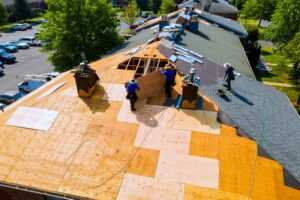When winter comes knocking, it brings snow, ice, winds, and freezing temperatures. With any luck, most of us will have a warm house to stay safe throughout the season. But if your windows are not well insulated, you might feel like you are outside in the snow — and notice that your heating bills are climbing.
Good windows are more than just ways to let light into your house. They also help regulate the temperature in your home, even during bitter temperatures. If you notice that you are losing heat through your windows, here are a few ways to reduce it.
Why Am I Losing Heat Through My Windows?
There are a few ways that windows let heat escape. This usually comes down to problems either with the window parts themselves or with the window installation.
Problems with the parts of the windows usually mean that the components are poor quality or outdated. This could mean using single-pane glass rather than double- or triple-pane or aluminum rather than vinyl. If you are responsible for getting new windows installed, make sure you choose models made from high-quality, heat-retaining materials.
Another reason you might be losing heat through your windows is because of the installation. This could be a problem that originated when the window was first put in, or it could have developed with time and age. This usually means that the windows have gaps between the frame and the wall that let air pass through too easily.
If the source of your poor window insulation is the installation, you can fix the problem by filling those gaps. Thankfully, there are a number of ways to improve your windows’ performance throughout the winter.
How Do I Know If My Windows Are Letting Heat Out?
The good news is that if your windows are not working as they should, it is obvious in most cases. You will probably feel cold air or a draft if you hold your hand up to the window — and if cold air is coming in, it’s a sign that warm air is going out.
If you inspect the window visually, you might notice that there are visible gaps, cracks, or holes around the window frame.
You may have also heard of the infamous candle test. If you are still unsure how well your windows are working, try lighting a candle and then blowing it out while holding it up to the window. Keep an eye on how the smoke moves. If you have an invisible gap in the frame or if air is passing through the window, the smoke will get sucked through the gap.
How To Improve Your Window Insulation
The good news is that if your windows are not cutting it this winter, you do not necessarily need a major repair. There are a few ways that you can keep your house warmer throughout the winter. Most of these are fairly simple and affordable, making them a good option for anyone who needs a quick solution!
Insulation Film
Although most of the time, the glass is not the culprit behind heat loss, insulation film may still help. This thin plastic film attaches directly to the window to add an extra layer where cold air is trapped. You can find insulation film at most home improvement stores, and it is easy to install. There are several types, including a removable and reusable film that sticks to your window with magnets.
Weather Strips
Weather strips are small, adhesive pieces of insulation designed to fill the gaps between the window and the wall. They are put on like tape and can be easily removed when winter is over. Like insulation film, you can find weather strips at most home improvement stores that take only a few minutes to apply.
Caulking
If you have done a few minor house repairs, you probably know what caulk is. This squeezable paste fills gaps between fixtures and the wall or floor. This includes windows. If you pinpoint the problem as gaps in your window frame, caulking may help. This is a quick way to seal the space and insulate your windows without installing any extra fixtures.
Honeycomb Shades
Honeycomb shades are one of several window treatment options that reduce heat exchange. They get their name from the distinctive shape, which resembles a honeycomb. The thickness and extra space inside them make them highly effective at keeping cold air from coming in through your windows. It is worth noting that this might be more expensive than some of the other DIY options for insulating windows.
Thermal Curtains
Sometimes, it might be best to skip the repairs and go with thermal curtains. These extra-thick curtains are made to seal off windows, reducing air exchange and improving ventilation. They can be used year-round to regulate your home’s temperature and reduce your heating and cooling bills. Some people prefer not to use them because they block out much natural light, but they might be a good choice for your needs.
Draft Stoppers
If you want to keep things really simple, adding a draft stopper might help. You can buy or even make one of these. The drawback is that they are only made for the bottom of a door or window, which means they provide less insulation than other methods.
Internal Insulation
If you pinpoint the problem as poor sealing around your windows, you may be able to benefit from adding internal insulation. This includes spray insulation foam or fiberglass. However, this method requires removing the window from its frame, so it requires a bit of know-how before you can tackle it.
Get Started with Freeman Exteriors Today
All of these DIY fixes can help keep you warm for the short term, but they will not turn a bad window into a good one. A permanent fix requires professional knowledge and expertise. If you think it is time for better-insulating windows in your home, our experts at Freeman Exteriors are ready to guide you through the process. Contact us at (217)-355-5447 to schedule an estimate for your next project.




